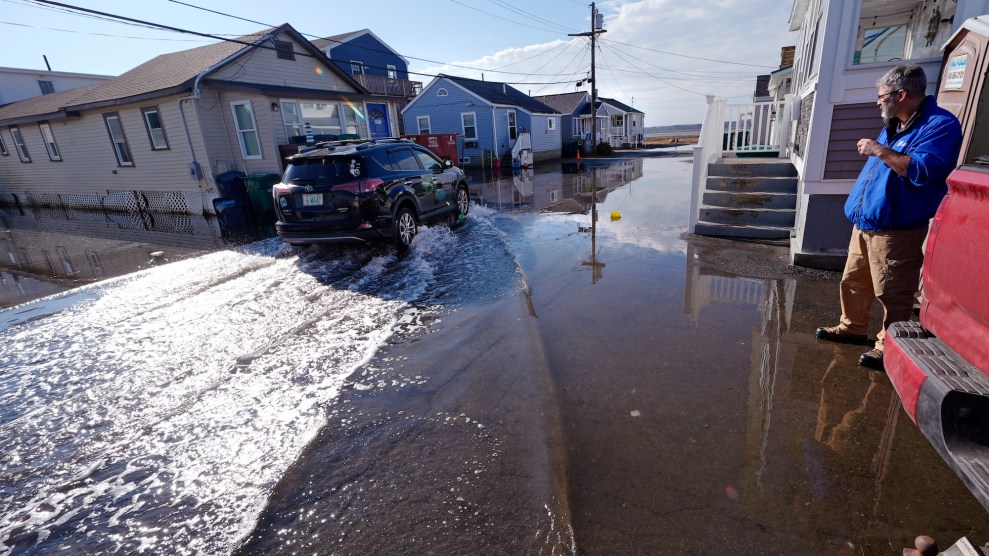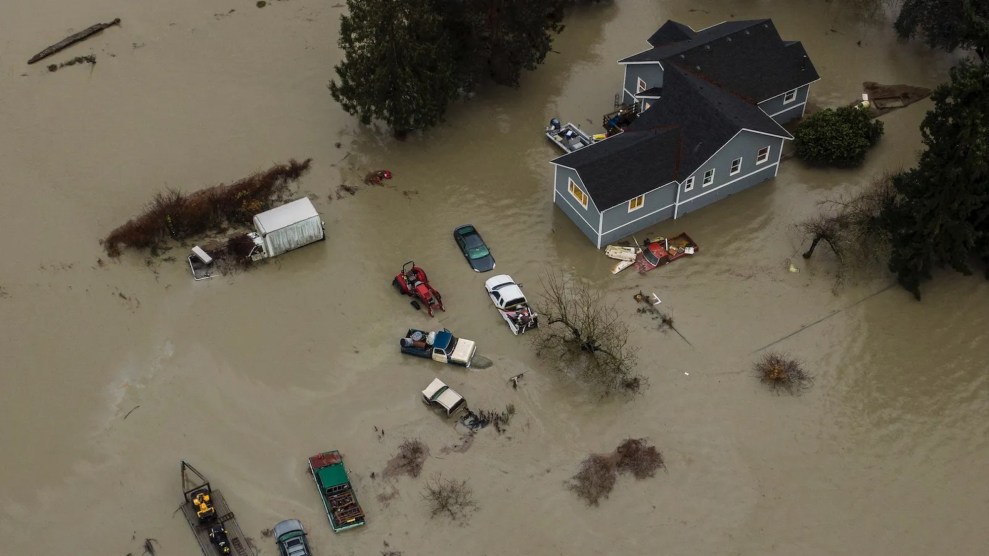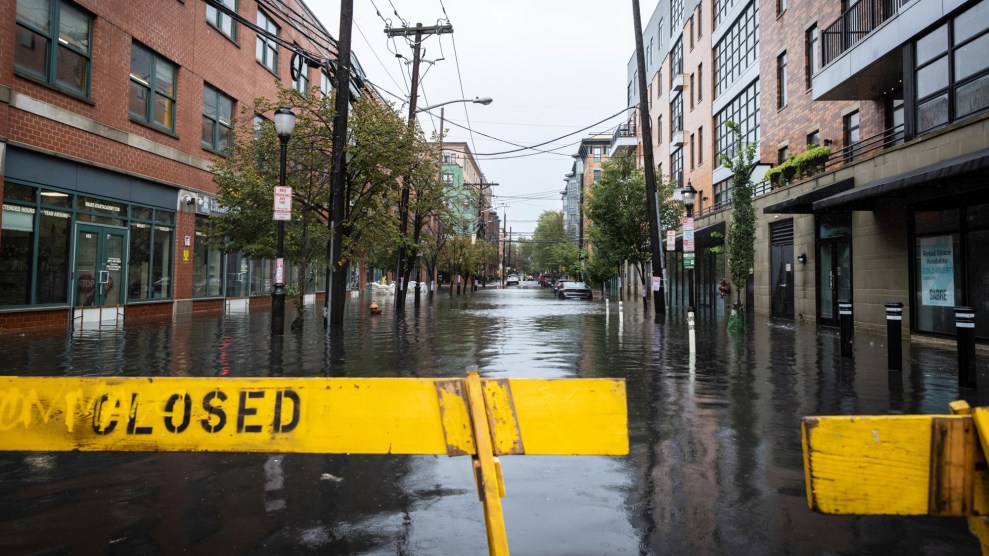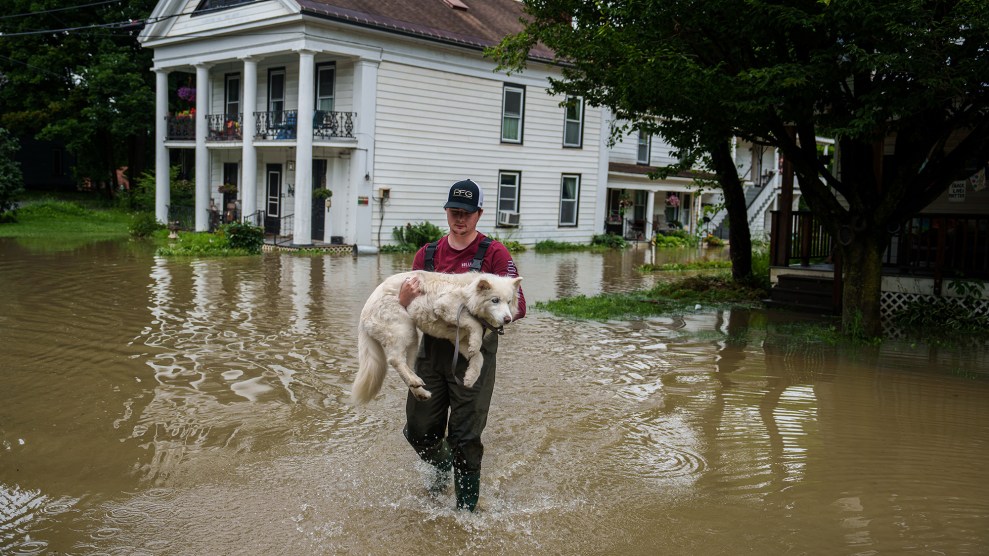
Flooding in Hampton, New Hampshire – on the Atlantic Coast – in January 2024 stormsCharles Krupa/AP
This story was originally published by Inside Climate News and is reproduced here as part of the Climate Desk collaboration.
Flooding could affect one out of every 50 residents in 24 coastal cities in the United States by 2050, a study led by Virginia Tech researchers suggests.
The study, published this month in Nature, shows how the combination of land subsidence—in this case, the sinking of shoreline terrain—and rising sea levels can lead to the flooding of coastal areas sooner than previously anticipated by research that had focused primarily on sea level rise scenarios.
“One of the things we wanted to do with this study is really emphasize the impact of land subsidence, which is often not reflected in most of the discussion around sea level rise,” said Leonard Ohenhen, the lead author of the study and a graduate student at Virginia Tech’s Earth Observation and Innovation Lab.
The study combines measurements of land subsidence obtained from satellites with sea level rise projections and tide charts, offering a more holistic projection of potential flooding risks in 32 cities located along the Atlantic, Pacific and Gulf coasts.
The satellites bounce signals off the Earth and measure the time it takes for them to return, allowing the researchers to determine whether the distance between the ground and the satellites is increasing or decreasing. Less distance between the ground and the satellites would mean that the land is rising, while increases in that distance would show that the land is sinking.
The study found that out of the 32 coastal cities examined, 24 are sinking more than 2 millimeters per year. Half of these cities have specific areas that are sinking faster than the global sea levels are rising.
Up to 500,000 individuals living in these regions may be impacted in the next 30 years, with potentially one in every 35 private properties facing flooding damages.
Most conversations around climate change impacts involve projections for the end of the century, Ohenhen said. The team’s goal with this study was to look at the short term and show the existing hazards. “We tend to think of the consequences of climate change as a long term effect,” he said. “Which makes people feel like you cannot really account for all of the changes or the things that will happen before that time. And that often leads to underpreparation.”
The year 2050, often cited in climate discussions, is not an end point but rather a marker of the immediacy of the issue, said Robert Nicholls, director of the Tyndall Centre for Climate Change Research and professor at the University of East Anglia in the UK, who was a contributing author to the study.
The research anticipates that the 32 cities under consideration will collectively house approximately 25 million people and 10 million properties by 2050. It found ethnic minorities, especially in the Gulf Coast region, could face disproportionate impacts.
Minorities constitute roughly 43 percent of the population in the 11 Gulf Coast cities the study includes. However, they are expected to represent between 64 to 72 percent of the population at risk of flooding by 2050, the research shows. African Americans, in particular, are projected to make up over half of this vulnerable population.
The first step in tackling the challenge of flooding isn’t necessarily adaptation, but rather recognizing that it’s a problem, said Nicholls.
“It’s really a wake up call to think about how we’re going to live with this changing interface between the land and the sea,” Nicholls said of the study.
Structural adaptation strategies vary widely, from building protective walls to raising buildings on stilts or elevated mounds of earth, a more common practice in many areas of the US, Nicholls said. These strategies can help protect properties from flooding.
Natural habitats and coastal ecosystems have some degree of protection against sea level rise hazards, but they won’t protect communities from all of the challenges that sea level rise could pose, Siddharth Narayan, an assistant professor at East Carolina University, said.
“So it’s going to be a combination of long-term structural adaptations and solutions wherever possible and conserving and maintaining our natural spaces to add a little bit of a buffer,” Narayan said.
Marsh restoration, coral reefs and dunes can provide a natural barrier, said Andra Garner, an assistant professor at Rowan University.
It’s still uncertain what sea level rise impacts might look like in the future, Garner said. That uncertainty, she said, comes from a lot of places—including human behavior.
Garner was the lead author of a 2023 study published in Earth’s Future, which surveyed 54 coastal locations in the US and found that more than half underestimated the future sea level rise projections by the UN’s Intergovernmental Panel on Climate Change.
“It’s important that these communities that are at risk really are using the tools available to try to plan for sea level rise and to be working towards solutions that can benefit those that are exposed,” Garner said.













